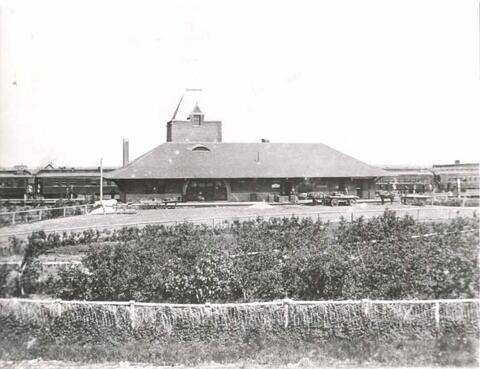
Title and statement of responsibility area
Title proper
CPR Station, Regina, Saskatchewan
General material designation
- Graphic material
Parallel title
Other title information
Title statements of responsibility
Title notes
Level of description
Item
Repository
Reference code
Edition area
Edition statement
Edition statement of responsibility
Class of material specific details area
Statement of scale (cartographic)
Statement of projection (cartographic)
Statement of coordinates (cartographic)
Statement of scale (architectural)
Issuing jurisdiction and denomination (philatelic)
Dates of creation area
Date(s)
-
ca. 1897 (Creation)
- Place
- Regina (N.W.T.)
Physical description area
Physical description
1 photograph : b&w ; 20.5 x 25 cm
Publisher's series area
Title proper of publisher's series
Parallel titles of publisher's series
Other title information of publisher's series
Statement of responsibility relating to publisher's series
Numbering within publisher's series
Note on publisher's series
Archival description area
Custodial history
Scope and content
Canadian Pacific Railway (CPR) Station in Regina, located on South Railway Street; note Stanley Park (Regina's first park/green space) in front of station
Notes area
Physical condition
Immediate source of acquisition
Arrangement
Language of material
Script of material
Location of originals
Availability of other formats
Restrictions on access
Terms governing use, reproduction, and publication
Copyright holder: Public Domain
Finding aids
Associated materials
Accruals
General note
In the early 20th century conversations at Canadian railway stations passed beyond daily schedules and fares and often turned towards horticultural concerns; soil quality, bedding plans and perennial favorites.
Along side station houses across the country, bright and abundant gardens were conceived and meticulously maintained by the railway company. The CPR gardening campaign began informally with station agents picking up spades and planting annuals to pass the time. Soon, the growing interest led CPR to integrate garden design and upkeep into company policy, encouraging pleasing and elaborate station gardens.
By 1915 the CPR had a forestry department, a floral committee, company owned greenhouses and over 1000 blooming gardens along the train tracks. Station agents spent as much time reviewing seed inventories as rail schedules. The diligence with which the gardens were cared for reflected the CPR's desire to tidy up the rail yards and welcome settlers to the West by showcasing the productive splendor of prairie land.
In 1917 the Floral Committee issued a circular to station agents with a request to move away from annuals that predominated in gardens and embrace hardy perennials. An excerpt from the Canadian Railway and Marine World periodical (March 1917, p.103):
"With the object of establishing permanent gardens throughout the system, it has been decided to supply perennial plants on request. These flowering plants remain alive in the ground through severe winters and most of them bloom early in the spring....A suitable collection for the average garden should include approximately five of each of the following plants: Achillea, Campanula, Sweet William, Larkspur, Columbine, Icelandic poppy, Pinks or Dianthus, Gaillardia, Bleeding Heart, Peony, Phlox, Golden Glow, Native hop."
By the 1950’s railway gardens began to fade along with passenger rail traffic, and the CPR ceased to champion horticultural activities. Without sustained effort and interest, station agents no longer moonlighted as accomplished gardeners and the once verdant campaign came to a close.
Alternative identifier(s)
Standard number area
Standard number
Access points
Subject access points
Place access points
Name access points
- Canadian Pacific Railway (CPR) (Subject)
- Canadian Pacific Gardens Park (Regina) (Subject)

